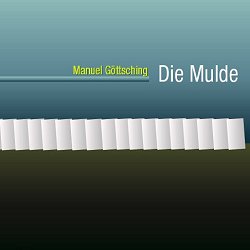|
|
|
 |
Manuel Göttsching: Die Mulde
Press Reviews |
 |
 |
(In English, will be opened in a new window) (Sonic Curiosity, USA, 2001) |
|
 |
 |
(In English, will be opened in a new window) (Tokafi, Germany, 2007) |
|
 |
 |
(In French, will be opened in a new window) ("Guts of Darkness", Canada, 2006) |
|
 |
 |
(In German, will be opened in a new window) ("Keys", Germany, March 2006) |
|
 |
 |
(In English, will be opened in a new window) (Eurock, USA) |
|
 |
 |
(In English, will be opened in a new window) (Sonic Curiosity, USA) |
|
 |
 |
»I received your new releases. Thank you very much. I listened to the
CDs and I enjoyed them. I knew Die Mulde from VHS before. It has
always impressed me very deep. I'm surprised by the length of E2-E4
Live. I expected it would be as long as the original recording. I
like additional phrases of non-electric instruments that were not
hearable before. Recently, I often listen to music made by traditional
sound. It's why I enjoyed Concert for Murnau too.« (Arthur Lason, Poland) |
|
 |
 |
(In German, will be opened in a new window) |
|
 |
 |
»Die Mulde ist eine über 72minütige CD, deren Hauptteil aus dem 40minütigen Titelstück, das in vier Tracks unterteilt ist, besteht. Aufgenommen wurde die Musik bei einem Konzert, die Manuel am 06.09.1997 in der Denkmalschmiede Höfgen im Rahmen eines Kunstprojektes aufgeführt hat. In der Nähe des Flusses Mulde hatte Mercedes Engelhardt eine Installation von 34 Spiegeln angebracht. Zu diesem imposanten Werk lieferte Manuel seine aus vier Teilen bestehende Suite. Bereits im Jahr 2002 erschien dieser Auftritt auf VHS-Kassette, die Musik wurde in 2005 völlig neu im Studio von Manuel abgemischt und liegt jetzt als CD vor. Wie der Sound zu einem landenden UFO startet Part 1 Schöpferische Stille, das mit knapp drei Minuten der kürzeste Track des Titelstücks ist. Dann kombiniert Manuel beim folgenden Die Mulde diesen Sound mit Phrasen aus sanften Flächen, die sich zu langsamen Melodielinien formen und in einen rhythmischeren Teil übergehen. Den Übergang zu Die Spiegel bildet ein Rhythmusloop, der die Grundlage für diesen Teil darstellt, der sich durch leichte Veränderungen entwickelt. Bis auf das Ende dieses Teils, das durch sehr schöne Rhythmussounds glänzt, ist dieser Teil für meinen Geschmack etwas zu eintönig. Diesen Rhythmus nimmt er dann mit in den nächsten Track Zerfluss rüber, der dann einen industriellen Touch annimmt und dadurch den Hörer in eine Art Trance versetzt. Tolles Teil. Manuel spielt im gesamten Track mit unterschiedlichen Effekten, der Lautstärke, setzt unterschiedliche Rhythmen ein und hält so über die Länge des Stückes die Spannung aufrecht. Als weiteren Titel hat Manuel den Ambienttrack HP Little Cry dem Silberling spendiert. Dieser Track basiert auf einem bereits in den 80er Jahren entstandenen Stück, das Manuel im Jahr 2004 um eine Gitarrenaufnahme anreicherte, so dass ein neuer, bisher unveröffentlichter Track entstand. Auf der recht monotonen Grundfläche spielt Manuel eine recht experimentell angelegte Gitarre.« |
|
 |
 |
»When Manuel Göttsching releases an album, he asks of his fans many things. While devotees look for references to classic works, Göttsching asks us to look ahead to new revelations. On Die Mulde (72'23") both expectations are met. The first four tracks cover the movements of the title piece. Die Mulde (40'07") slowly builds from slow and spacey into warm shifting pads. Layers of electronic rhythms gradually rise and engage with the motion of synthesizer chords. The music cycles through a striking progression of contrasting and resolving chords and harmonies until fading off into the distance. With the track hp little cry (32'16") the mood and outlook of the album turns toward a more serene eloquence. Made up of sustaining synth drones and clean electric guitar soloing, Göttsching demonstrates a mastery of simple forms and subtle effects. The guitar lines are conversant, with a sense of drama and direction. The piece's pliant tone and stark intimacy provide a quiet elegance. One wonders why Göttsching waited until this stage of his life's work to create this music. He certainly had the virtuosity to play it all along, but perhaps not the perspective. This piece reveals the touch of the player, but also the heart of the man.« |
|
 |
 |
(In French, will be opened in a new window) |
|
 |
 |
(In German, will be opened in a new window) (Thomas Meinecke (Bayerischer Rundfunk), December 2005, Germany) |
|
 |
 |
(In Italian, will be opened in a new window) (Movimenti Prog, December 2005, Italy) |
|
[Die Mulde - Main Page]

|
|

|
Search this website
Use the form below to search the pages of our website
(but don't expect from this little search routine the power and flexibility
of the common Internet search engines...)
Enter one or more keywords separated by blanks.
Please do not use words with non-English characters.
MANUEL on Youtube
Click here
Contact
General information about Manuel Göttsching
Press for press information
Webmaster for any information concerning this website
Legal Notices
Terms of Use
Privacy
Imprint/Impressum
© 2023 Manuel Göttsching.
All rights reserved.

|

|